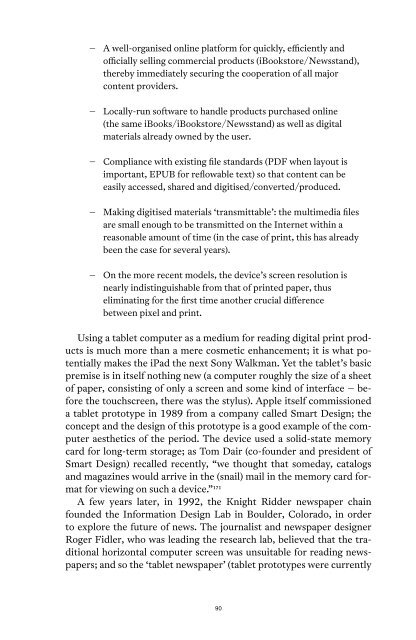Post- Digital Print - Monoskop
Post- Digital Print - Monoskop
Post- Digital Print - Monoskop
You also want an ePaper? Increase the reach of your titles
YUMPU automatically turns print PDFs into web optimized ePapers that Google loves.
– A well-organised online platform for quickly, efficiently and<br />
officially selling commercial products (iBookstore/Newsstand),<br />
thereby immediately securing the cooperation of all major<br />
content providers.<br />
– Locally-run software to handle products purchased online<br />
(the same iBooks/iBookstore/Newsstand) as well as digital<br />
materials already owned by the user.<br />
– Compliance with existing file standards (PDF when layout is<br />
important, EPUB for reflowable text) so that content can be<br />
easily accessed, shared and digitised/converted/produced.<br />
– Making digitised materials ‘transmittable’: the multimedia files<br />
are small enough to be transmitted on the Internet within a<br />
reasonable amount of time (in the case of print, this has already<br />
been the case for several years).<br />
– On the more recent models, the device’s screen resolution is<br />
nearly indistinguishable from that of printed paper, thus<br />
eliminating for the first time another crucial difference<br />
between pixel and print.<br />
Using a tablet computer as a medium for reading digital print products<br />
is much more than a mere cosmetic enhancement; it is what potentially<br />
makes the iPad the next Sony Walkman. Yet the tablet’s basic<br />
premise is in itself nothing new (a computer roughly the size of a sheet<br />
of paper, consisting of only a screen and some kind of interface – before<br />
the touchscreen, there was the stylus). Apple itself commissioned<br />
a tablet prototype in 1989 from a company called Smart Design; the<br />
concept and the design of this prototype is a good example of the computer<br />
aesthetics of the period. The device used a solid-state memory<br />
card for long-term storage; as Tom Dair (co-founder and president of<br />
Smart Design) recalled recently, “we thought that someday, catalogs<br />
and magazines would arrive in the (snail) mail in the memory card format<br />
for viewing on such a device.” 171<br />
A few years later, in 1992, the Knight Ridder newspaper chain<br />
founded the Information Design Lab in Boulder, Colorado, in order<br />
to explore the future of news. The journalist and newspaper designer<br />
Roger Fidler, who was leading the research lab, believed that the traditional<br />
horizontal computer screen was unsuitable for reading newspapers;<br />
and so the ‘tablet newspaper’ (tablet prototypes were currently<br />
90

















